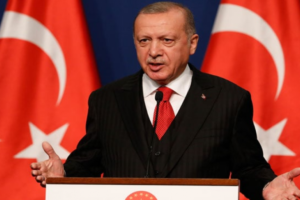A migrant shelter in southern Mexico called La 72 has for years been a popular way station for those traveling from Central America to the United States. Last year it received a record number of visitors, sometimes sheltering more than 2,000 a month.
In recent weeks, however, that traffic has come to a grinding halt and even gone into reverse.
Since late March, amid the coronavirus pandemic, no more than 100 migrants have passed through the shelter. And nearly all were heading south, trying to get back to their homes in Central America.
“We’ve never seen this before,” said Ramón Márquez, the former director of the shelter. “I’ve never seen anything slow migration like the coronavirus.”
Border closures, suspended asylum programs, interruptions in global transportation and stay-at-home lockdowns have drastically curbed migration around the world, particularly from poorer nations to rich ones.
In Latin America, once-crowded migratory routes that led from South America, through Central America and Mexico and to the United States have gone quiet, with the Trump administration seizing on the virus to close the border to almost all migrants.
But the phenomenon extends well beyond the Americas. The number of East Africans crossing the Gulf of Aden to seek work in the Gulf States has plunged. Farms in western Europe are contending with severe labour shortfalls as travel bans have blocked the movement of seasonal migrant laborers from Eastern Europe.
“The pandemic has essentially — not absolutely, but essentially — stopped international migration and mobility dead in its tracks,” said Demetrios G Papademetriou, co-founder and president emeritus of the Migration Policy Institute in Washington.
In some places, migratory flows have seemingly made a U-turn, as migrants no longer able to earn a living abroad have decided to return home, even if their home countries are mired in political conflict and economic ruin.
Thousands of Venezuelans who had sought sanctuary and work in Colombia in recent years have crossed back into Venezuela, Afghans have returned home from Iran and Pakistan and Haitians from the Dominican Republic.
“We’re finding mass numbers moving back to their countries of origin because they cannot survive,” Gillian Triggs, assistant high commissioner for protection at the United Nations Refugee Agency, said in an interview.
Many of those who are returning barely had a toehold in the informal labour sector in their adopted countries and were denied access to social safety nets. “They are the people who are at the bottom of the pyramid,” Triggs said. “And they are almost always the first to go.”
In recent years, one of the world’s busiest migration corridors has run through Central America and Mexico, with tens of thousands of people reaching the southwest border of the United States every month, either to apply for asylum or try to slip undetected into the country.
Arrests of undocumented migrants at that border have long stood as a measure, however imperfect, of changes in the regional migration flows.
In March, US authorities arrested 29,953 migrants there, a slight drop from the previous month’s total. But migration experts say April’s numbers, when they are finally published, may reflect a significant decrease in migration.
Shelter managers and migrants’ advocates throughout the region said they had seen migrant traffic slow to a trickle in recent weeks.
The Rev. Pat Murphy, director of Casa del Migrante, a shelter in Mexican border city Tijuana, said that only about 10 people had shown up at his door in the past two weeks looking for a place to sleep — and that most had just been deported from the United States rather than travelled from the south.
But Murphy and most other shelter operators in Tijuana and elsewhere have closed their doors to new arrivals as a way of protecting quarantined residents. And some shelters in the region have shut down entirely for fear of becoming places of contagion. One shelter, Casa del Migrante Nazareth in Mexican border city Nuevo Laredo, suspended operations after it suffered an outbreak that sickened at least 15 residents.
Most of the migrants who have reached the southwest border of the United States in the past year have been from Central America, but advocates say that the particularly stringent lockdown and border-control measures throughout that region have persuaded some to delay their departures until the situation eases.
Migrants have also been discouraged by the Trump administration’s decision last month to severely tighten border restrictions. Citing the threat of the coronavirus, the administration instituted a new policy under which it has been quickly deporting people who illegally cross the southwest border of the United States. The administration also halted processing of unauthorised migrants at ports of entry.
The changes have effectively blocked access at the southwest border for migrants seeking asylum.
“I would hazard to say that the only migration that’s working now is migration with smugglers,” said Márquez, the former director of La 72 migrant shelter, which is in Tenosique, near Mexico’s border with Guatemala.
The United States is not an outlier. All over the world, governments have temporarily closed their doors to refugees seeking protection.
Triggs said that of more than 120 countries that have ordered some form of border closure, only about 30 of them are giving any consideration to the claims of asylum-seekers. Most countries, she said, “have closed their borders, terminated their asylum process and are pushing back.”
And resettlement of refugees she said, “has stopped for all practical purposes” because of limitations in air travel.
Erol Yayboke, a senior fellow at the Center for Strategic and International Studies in Washington, said he anticipated that even once the pandemic fades, protectionist impulses among some leaders in wealthy nations may continue, thwarting a complete resumption of long-standing migration patterns.
Instead, Yayboke said, flows may be greater than normal between developing countries that pose fewer restrictions on migration.
“I think that once you turn the faucet back on, it’s not going to immediately flow,” he said. “And when it does flow, it’s not necessarily going to flow in the same direction.”





















